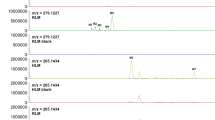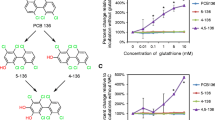Abstract
Phenethyl isothiocyanate is a chemopreventive phytochemical present in cruciferous vegetables where it exists as the glucosinolate gluconasturtiin. It is a mechanism-based inhibitor of both rat and human cytochrome P450 enzymes. The principal objective of the present study was to ascertain whether phenethyl isocyanate, formed by the cytochrome P450-mediated oxidative desulphuration of phenethyl isothiocyanate, is the metabolite responsible for the mechanism-based inhibition. Phenethyl isothiocyanate, following incubation with Aroclor 1254-induced rat liver microsomes in the presence of NADPH, markedly suppressed the CYP1A-mediated O-deethylation of ethoxyresorufin; extent of inhibition was directly related to the pre-incubation time and was antagonised by reduced glutathione. When human liver microsomes were used, the inhibitory effect of phenethyl isothiocyanate, which was once again related to the pre-incubation time, was even more pronounced. When the ability of phenethyl isothiocyanate and phenethyl isocyanate to directly inhibit the O-deethylation of ethoxyresorufin in rat microsomes was compared, the latter compound was only moderately more effective. In human microsomes, both compounds were equipotent. In phenobarbital-induced lung microsomes, phenethyl isothiocyanate was a direct and potent inhibitor of the O-depentylation of pentoxyresorufin; pre-incubation of the isothiocyanate had no impact. Human precision-cut liver slices were more effective than rat slices in metabolising phenethyl isothiocyanate. Pre-treatment of rats, however, with phenobarbitone significantly enhanced the metabolism of isothiocyanate. It may be inferred from the present studies that: (a) phenethyl isocyanate is not the metabolite of phenethyl isothiocyanate responsible for its mechanism-based inhibition, and (b) CYP2B is an important catalyst of the metabolism of phenethyl isothiocyanate.







Similar content being viewed by others
References
Al Janobi AA, Mithen RF, Gasper A, Shaw PN, Middleton R, Ortori C, Barrett D (2006) Quantitative measurement of sulforaphane, iberin and their mercapturic acid pathway metabolites in human plasma and urine using liquid chromatography-tandem electrospray ionisation mass spectrometry. J Chrom B 844:223–234
Ambrosone CB, McCann SE, Freudenheim JL, Marshall JR, Zhang Y, Shields PG (2004) Breast cancer risk in premenopausal women is inversely associated with consumption of broccoli, a source of isothiocyanates, but is not modified by GST genotype. J Nutr 134:1134–1138
Anwar-Mohamed A, El-Kadi AOS (2009) Sulforaphane induces CYP1A1 mRNA, protein and catalytic activity levels via an AhR-dependent pathway in murine hepatoma Hepa1c1c7 and human HepG2 cells. Cancer Lett 275:93–101
Bheemreddy BM, Jeffery EH (2007) The metabolic fate of purified glucoraphanin in F344 rats. J Agric Food Chem 55:2861–2866
Boysen G, Kenney PMJ, Upadhaya P, Wang M, Hecht SS (2003) Effects of benzyl isothiocyanate and 2-phenethyl isothiocyanate on benzo[a]pyrene and 4-(methylnitrosamino)-1-(3-pyridyl)-1-butanone metabolism in F-344 rats. Carcinogenesis 24:517–525
Bradford MM (1976) A rapid and sensitive method for the quantitation of microgram quantities of protein utilising the principle of protein-dye binding. Anal Biochem 72:248–254
Burke MD, Mayer RT (1974) Ethoxyresorufin: direct fluorimetric assay of a microsomal O-dealkylation which is preferentially inducible by 3-methylcholanthrene. Drug Metab Dispos 2:583–588
Dingley KH, Ubick EA, Chiarappa-Zucca ML, Nowell S, Abel S, Ebeler SE, Mitchell AE, Burns SA, Steinberg FM, Clifford AJ (2003) Effect of dietary constituents with chemopreventive potential on adduct formation of a low dose of the heterocyclic amines PhIP and IQ and phase II enzymes. Nutr Cancer 46:212–221
El-Hawari AM, Plaa GL (1977) Alpha-Naphthylisothiocyanate (ANIT) hepatotoxicity and irreversible binding to rat liver microsomes. Biochem Pharmacol 26:1857–1866
Getahun SM, Chung FL (1999) Conversion of isothiocyanates in humans after ingestion of cooked watercress. Cancer Epidemiol Biomar Prev 8:447–451
Goosen TC, Kent UM, Brand L, Hollenberg PF (2000) Inactivation of cytochrome P450 2B1 by benzyl isothiocyanate, a chemopreventative agent from cruciferous vegetables. Chem Res Toxicol 13:1349–1359
Goosen TC, Mills DE, Hollenberg PF (2001) Effects of benzyl isothiocyanate on rat and human cytochromes P450: identification of metabolites formed by P450 2B1. J Pharmacol Exp Ther 296:198–206
Hanlon N, Okpara M, Coldham N, Sauer MJ, Ioannides C (2008a) Modulation of rat hepatic and pulmonary cytochromes P450 and Phase II enzyme systems by erucin, an isothiocyanate structurally related to sulforaphane. J Agric Food Chem 56:7866–7871
Hanlon N, Coldham N, Sauer MJ, Ioannides C (2008b) Up-regulation of the CYP1 family in rat and human liver by the aliphatic isothiocyanates erucin and sulforaphane. Toxicology 252:92–98
Hanlon N, Coldham N, Sauer MJ, Ioannides C (2009) Modulation of rat pulmonary carcinogen-metabolising enzyme systems by the isothiocyanates erucin and sulforaphane. Chem-Biol Interact 177:115–120
Hashemi E, Dobrota M, Till C, Ioannides C (1999) Structural and functional integrity of precision-cut liver slices in xenobiotic metabolism: a comparison of the dynamic organ and multiwell plate culture procedures. Xenobiotica 29:11–25
Hecht SS, Trushin N, Rigotty J, Carmella SG, Borukhova A, Akerkar SA, Rivenson A (1996) Complete inhibition of 4-(methylnitrosamino)-1-(3-pyridyl)-1-butanone induced rat lung tumorigenesis and favorable modification of biomarkers by phenethyl isothiocyanate. Cancer Epidemiol Biomark Prev 5:645–652
Higdon JV, Delage B, Williams DE, Dashwood RH (2007) Cruciferous vegetables and human cancer risk: epidemiologic evidence and mechanistic basis. Pharmacol Res 55:224–236
Kassahun K, Davis M, Hu P, Martin B, Baillie T (1997) Biotransformation of the naturally occurring isothiocyanate sulforaphane in the rat: identification of phase I metabolites and glutathione conjugates. Am Chem Soc 10:1228–1233
Konsue N, Ioannides C (2008) Tissue differences in the modulation of rat cytochromes P450 and phase II conjugation systems by dietary doses of phenethyl isothiocyanate. Food Chem Toxicol 46:3677–3683
Konsue N, Kirkpatrick J, Kuhnert N, King LJ, Ioannides C (2009) Repeated oral administration modulates the pharmacokinetic behaviour of the chemopreventive agent phenethyl isothiocyanate in rats. Mol Nutr Food Res (in press)
Lee M-S (1992) Oxidative conversion by rat liver microsomes of 2-naphthyl isothiocyanate to a 2-naphthyl isocyanate, a genotoxicant. Chem Res Toxicol 5:791–796
Lee M-S (1994) Oxidative conversion of isothiocyanates to isocyanates by rat liver. Environ Health Perspect 102:115–118
Lee M-S (1996) Enzyme induction and oxidative desulfuration of isothiocyanates to isocyanates. Chem Res Toxicol 9:1072–1078
London SJ, Yuan JM, Chung FL, Gao YT, Coetzee GA, Ross RK, Yu MC (2000) Isothiocyanates, glutathione S-transferase M1 and T1 polymorphisms, and lung cancer risk: a prospective study in Shanghai, China. Lancet 356:724–729
Lubet RA, Mayer RT, Cameron JW, Nims RN, Burke MD, Wolf T, Guengerich FP (1985) Dealkylation of pentoxyresorufin: a rapid and sensitive assay for measuring induction of cytochrome(s) P450 by phenobarbital and other xenobiotics in the rat. Arch Biochem Biophys 238:43–48
Moreno RL, Kent UM, Hodge K, Hollenberg PF (1999) Inactivation of cytochrome P450 2E1 by benzyl isothiocyanate. Chem Res Toxicol 12:572–587
Moreno RL, Goosen T, Kent UM, Chung F-L, Hollenberg PF (2001) Differential effects of naturally occurring isothiocyanates on the activities of cytochrome P450 2E1 and the mutant P450 2E1 T303A. Arch Biochem Biophys 391:99–110
Nakajima M, Yoshida R, Shimada N, Yamazaki H, Yokoi T (2001) Inhibition and inactivation of human cytochrome P450 isoforms by phenethyl isothiocyanate. Drug Metab Dispos 29:1110–1113
Nishikawa A, Furukawa F, Uneyama C, Ikezaki S, Tanakamaru Z, Chung F-L, Takahashi M, Hayashi Y (1996) Chemopreventive effects of phenethyl isothiocyanate on lung pancreatic tumorigenesis in N-nitrosobis(2-oxopropyl)amine-treated hamsters. Carcinogenesis 17:1381–1384
Omura T, Sato R (1964) The carbon monoxide pigment of liver microsomes. I. Evidence for its haemoprotein nature. J Biol Chem 239:2370–2378
Solt DB, Chang K-W, Helenowski I, Rademaker AW (2003) Phenethyl isothiocyanate inhibits nitrosamine carcinogenesis in a model for study of oral cancer chemoprevention. Cancer Lett 202:147–152
Steinbrecher A, Linseisen L (2009) Dietary intake of individual glucosinolates in participants of the EIPC-Heidelberg cohort study. Ann Nutr Metab 54:87–96
Stoner GD, Morissey D, Heu Y-H, Daniel M, Galati AJ, Wagner SA (1991) Inhibitory effects of phenethyl isothiocyanate on N-nitrosobenzylmethylamine carcinogenesis in the rat esophagus. Cancer Res 51:2063–2068
Tamura N, Aoki K, Lee M-S (1990) Characterization and genotoxicity DNA adducts caused by 2-naphthyl isocyanate. Carcinogenesis 11:2009–2014
Tice RR, Luke CA, Shelby D (1987) Methyl isocyanate: an evaluation of in vivo cytogenetic activity. Environ Mutagen 9:37–58
Verhoeven DT, Goldbohm RA, van Poppel G, Verhagen H, van der Brandt PA (1996) Epidemiological studies on brassica vegetables and cancer risk. Cancer Epidemiol Biomark Prev 5:733–748
Von Weymarn LB, Chun JA, Hollenberg PF (2006) Effects of benzyl and phenethyl isothiocyanate on P450 2A6 and 2A13: potential for chemoprevention in smokers. Carcinogenesis 27:782–790
Von Weymarn LB, Chun JA, Knudsen GA, Hollenberg PF (2007) Effects of eleven isothiocyanates on P450 2A6- and 2A13-catalyzed coumarin 7-hydroxylation. Chem Res Toxicol 20:1952–1959
Wattenberg LW (1977) Inhibition of carcinogenic effects of polycyclic aromatic hydrocarbons by benzyl isothiocyanate and related compounds. J Natl Cancer Inst 58:395–398
Yoxall V, Kentish P, Coldham N, Kuhnert N, Sauer MJ, Ioannides C (2005) Modulation of hepatic cytochromes P450 and phase II enzymes by dietary doses of sulforaphane in rats: Implications for its chemopreventive activity. Int J Cancer 117:356–362
Acknowledgments
Nattaya Konsue gratefully acknowledges financial support from the Ministry of Science and Technology, Royal Thai Government.
Conflict of interest statement
Neither author has any conflict of interest to declare.
Author information
Authors and Affiliations
Corresponding author
Rights and permissions
About this article
Cite this article
Konsue, N., Ioannides, C. Phenethyl isocyanate is not the metabolite of phenethyl isothiocyanate responsible for mechanism-based inhibition of cytochrome P450. Arch Toxicol 84, 751–759 (2010). https://doi.org/10.1007/s00204-010-0522-z
Received:
Accepted:
Published:
Issue Date:
DOI: https://doi.org/10.1007/s00204-010-0522-z




